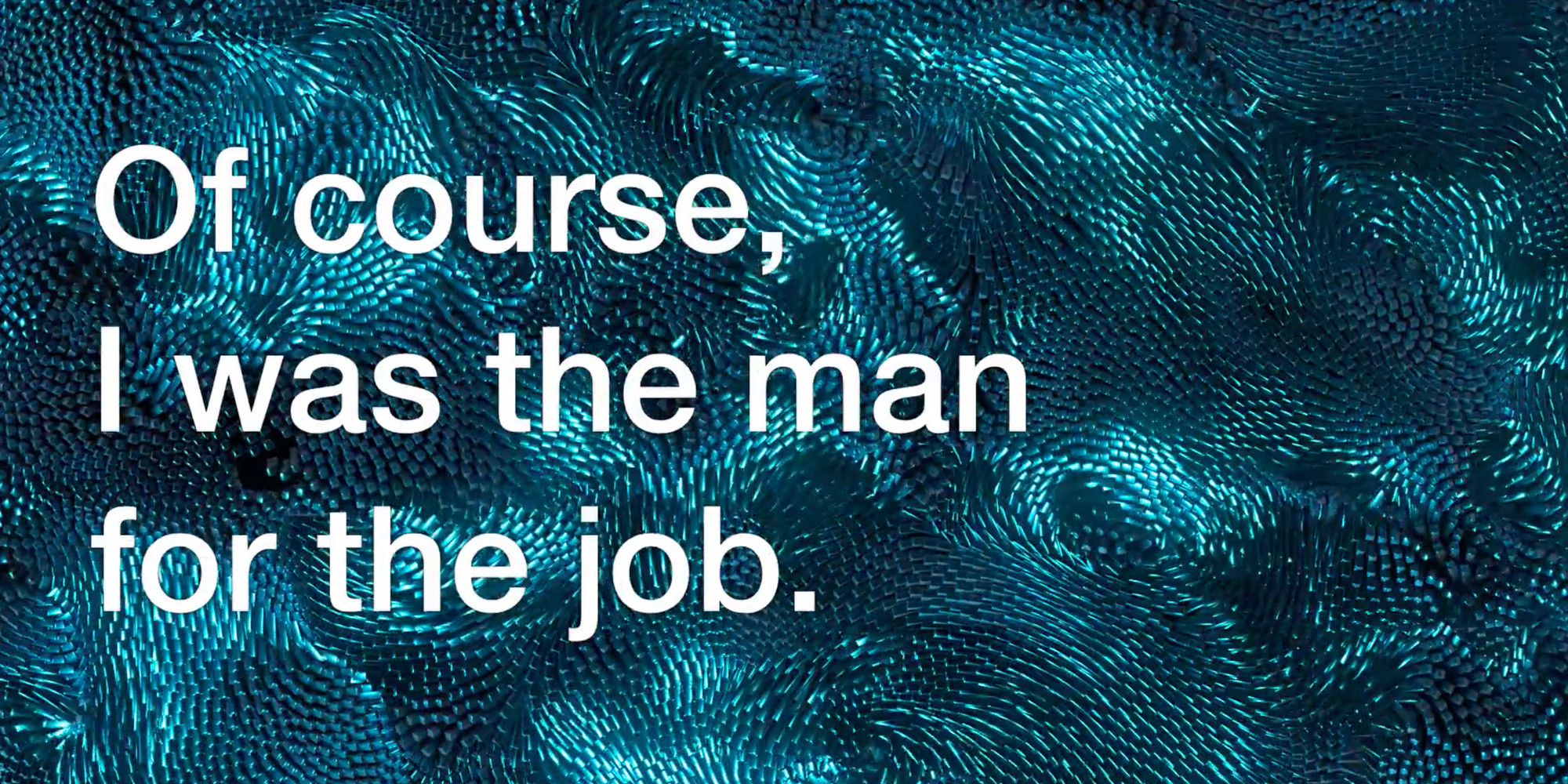
Tony Cokes’s The Will & The Way... Fragments 1 and 2
In this exclusive two-week screening, watch the artist examine the life of a groundbreaking architect.
Jan 12, 2022
Tony Cokes’s The Will & The Way... Fragments 1 and 2 screened here January 12–26, 2022. The video is no longer available for streaming. Join us for the next Hyundai Card Video Views screening, beginning February 16, 2022.
Since the late 1980s, Tony Cokes has produced a prolific body of videos that engage with critical theory, cultural studies, American politics, and popular culture. Typically set against monochrome fields of blue, red, or yellow, statements by public figures, from Donald Trump to the cultural theorist Mark Fisher, are reframed and paired with pop songs, hip-hop, and dance music. Cokes submits these texts to a precise and ruthless dressing down of forms of power that have long structured race, class, and gender.
In recent years, Cokes’s work has become increasingly attentive to architecture and spatial politics, appearing in iconic locations from Le Corbusier’s Carpenter Center at Harvard to London’s Piccadilly Circus. For an exhibition presented by Hannah Hoffman Gallery in Los Angeles in 2019, Cokes developed an installation for the private residence of mid-century architect Paul Revere Williams. The first African American member of the American Institute of Architects, Williams built over 2,500 notable homes and structures in Southern California. Considering what it means to occupy a space—and specifically what kinds of spaces some people have been allowed to occupy—Cokes developed a poignant reflection on Williams’s life and legacy, and its broader entanglement with the aspirations and shortcomings of modernism in its heyday. Cokes also contrasts Williams’s biography with the personal history of Aretha Franklin, who passed away on the same day Cokes made his first site visit to the Williams home. By drawing together these two disparate luminaries, Cokes raises the stakes for his archaeology of Blackness, creating public histories of individual struggle and accomplishment within a building designed as the ultimate expression of the American dream.
Celebrating MoMA’s recent acquisition of 16 videos by Tony Cokes, this month’s Hyundai Card Video Views presents the two chapters of the artist’s video The Will & The Way... (2019); each chapter will play for one week. I recently spoke to Cokes via Zoom about how the video came together and his practice at this challenging moment.
—Stuart Comer, The Lonti Ebers Chief Curator of Media and Performance
Stuart Comer: The subjects of your videos have ranged from Donald Trump to Michael Jackson, and in this case, you took as your subject the architect Paul Revere Williams. I’m curious how you gravitated to him and to his work in the first place.
Tony Cokes: Initially, I didn’t know a lot about Williams’s trajectory. I knew that he had done some homes for Hollywood people and also iconic municipal buildings, like the airport and one of the courts in Los Angeles. But I didn’t know very much about him at all, so this work became a kind of revelation.
I was particularly interested in a book that had been edited by his granddaughter; it’s an overarching account, both anecdotally and philosophically, of his approach to his practice. In the book there are two primary voices, one more anecdotal and vernacular, and then there are insertions of a very different viewpoint, talking about his own views on what design is, or can be. In my own work, too, there’s always that kind of relationship between the story aspect and a more analytic and theoretical angle. And so it was useful and interesting to pursue that. I looked at some other material as well, but it was something about the voice that drew me to the book.
We are presenting the two parts of the video, each for one week. I’m curious about how you arrived at this two-chaptered structure.
These videos were part of a commission, and had to be sited in Williams’s residence, and I try to think spatially about work when I’m doing an installation project. In the house there were two rooms that were perpendicular to each other, both facing a courtyard, and I was struck by that mirroring, and also by the differences between the two spaces. One was a formal living room, with wooden walls, usually carpeted, and it had a view of the garden. And on the other side there was a lanai, which was an indoor/outdoor space, with tile floors and brick walls.
So I thought that it might make sense to have some kind of doubling, formally. And also that it would be interesting to contrast Williams’s stories with something else, and I happened to be doing a site visit out in Los Angeles at the time that Aretha Franklin passed away. She was a central figure, especially to my mother, and it was interesting to think about what it would do to place them in a cross pattern, a kind of placement and displacement. So that’s how the formal aspect of the installation got decided. It was like, “Oh, I can have one channel about each of them in each room, at different scales, but rhyming.”
Sound is so critical to your work, especially pop music or club music. And I’m wondering how you arrived at using Radiohead in this video.
I often work with things that I’m listening to. This music came from a set of remixes from Radiohead’s The King of Limbs. When it was released I was aware of it, but hadn’t listened with the kind of attention that I was able to give it later. As is often the case, I was looking for music that would complicate the other materials that I was recruiting for a project. In this case, it had to be something immersive that might refer to traditional song forms or melodic forms, but not fully embody them. This music seemed to resonate with my decisions visually, and had hallucinogenic, naturalistic sort of references, which is something that I hadn’t worked with in some time. It was interesting to think about things that might refer, in an oblique way, to water, or to leaves, or to molten materials—to these kinds of moving patterns as opposed to a static juxtaposition between two colors or something like that.
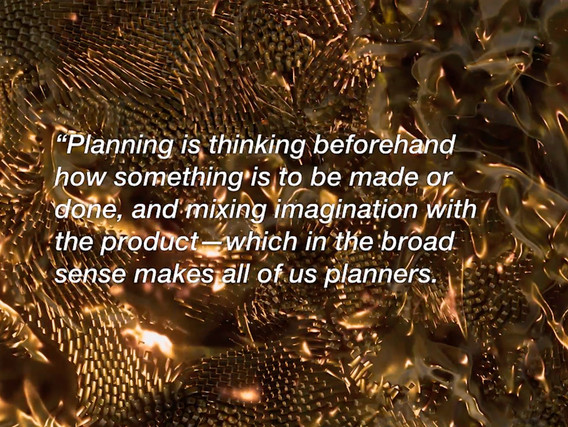
Tony Cokes. Still from The Will & The Way...Fragment 2. 2019
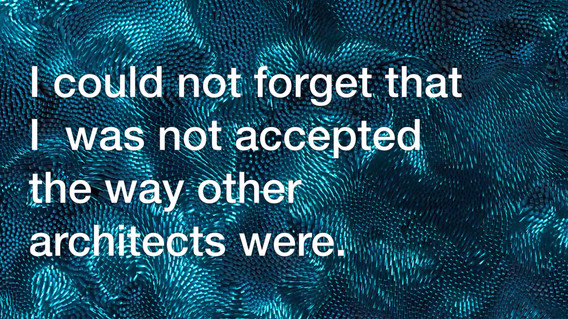
Tony Cokes. Still from The Will & The Way...Fragment 1. 2019
I find the graphics in this video so compelling, as well as the fact that you collaborated with a computer graphics specialist.
His name is Scott Pagano, and he had been my media editor for over a decade, but we had last worked together in 2012—well prior to this project. He had suggested these…. I guess you’d call them 4D modes of patterning to me before. He told me that people were using them in an advertising context, to simulate pours of liquid. They’re completely artificial on a certain level, and yet they seem to refer to some sort of naturalistic representation. I couldn’t think of a context in which they might operate, and then, all of a sudden, it was like, “Oh, yeah.” So I asked Scott to generate graphics that referred in some way to naturalistic things, like leaves or waves.
The combination of language, the references to the book, and these shifting, almost psychedelic images suggesting an idea about nature and technology—together they suggest a precarious chapter in the legacy of modernist architecture. The utopian moment of modernism seems a little jarring in relation to the climate crisis we’re in.
Yes, we’re a very long way from that ideal. I am interested in how the various attempts to capture those utopian hopes have either become complicated, or failed, or continue to disturb our ideal of modernism. That has long been an interest of mine—using modernist devices, but probably not in modernist ways. Or doubling down on some of those devices to hopefully pose questions about the things that we claim to know about those histories and legacies.
Among the creative fields, architecture remains one of the most overwhelmingly male and overwhelmingly white—something explored in MoMA’s recent exhibition Reconstructions. It is important that you use Williams’s words in this video, so it is not just a rereading of history, but a rereading from a first-person perspective, using his own personal account.
That singular voice is complicated, because I don’t know how much of the account has been edited, or how it was edited, and of course I edited it yet again. And then I juxtaposed it with another figure, Aretha Franklin, because I didn’t want it to be just a “great men” kind of thing.
I was also interested in how culture and politics are represented—or not—in Williams’s story. That’s one of the reasons why I was drawn to political and specific readings of Aretha Franklin’s career, in relation to the civil rights movement. Because in Williams’s book there are no direct references to this, except perhaps his response to getting an award from the NAACP.
But there are a lot of little resonances of race throughout the text, and it’s interesting to see where and how they surface. Something as simple as taking a train ride, or going to a hotel, or working on building spaces where he would personally not be able to live or be welcomed as a guest. But that’s a very different register than an account that amplifies political struggles in a direct way. It locates it at a more personal level, but at the same time I can’t help but read it in terms of social context. This was one way of encountering these problems and issues. But the issue of what kind of space you can occupy, or not, recurs through the text, raising the question of what Williams’s relationship was to the spaces he built, and how that relationship is inevitably related to race and inequality.
There are three strands of filmmaking that tend to be seen as separate, or even opposed to each other. One is narrative filmmaking, another is documentary filmmaking, and the third is structuralist filmmaking. To some extent, this video is all three, so there are a lot of cinematic codes being played with and fused in a really clever way.
In some ways, you could say that that’s my MO. I was trained by modernists who felt that there should be rigorous separations between formal play and descriptions of society or of individual lives. And I was sort of like, “Why is that, exactly?” It seemed to me that a more useful and complex model would combine all of these codes and expectations. I often say that I love the “document” in documentary. I often work with transcriptions of interviews, or things that might appear in a documentary, except that I don’t treat them in that way. I run them through conceptual and structural modalities, because I think that there are multiple potentials for legibility in these kinds of combined codes, as opposed to trying to keep the codes discrete from one another. That’s something I never really understood.
In the 1990s, there was a resurgence of interest in what was called sentimental conceptualism, or romantic conceptualism, which was trying to suggest that Conceptual art doesn’t always have to be dry and clinical, which is the way it had often been perceived. In your work, the music in particular delivers a level of affect that has not been traditionally associated with Conceptual art.
I’d say that in my work I strive for thinking and feeling at once. You know, is it possible to think, dance, and act in the world simultaneously? Affect can be as useful in its way as analysis.
Increasingly, your work is shown in very large public spaces, like Piccadilly Circus. At the same time, it became very present in the virtual world during the pandemic. It had a certain urgency in that moment, and it was great to see it being shared online, by a variety of institutions, internationally. So I’d like to ask how you’re thinking about navigating civic space, both on a large-scale, physical level, and through the Internet.
I love the idea that something that I developed on my laptop, this device that we’re communicating through right now, could also exist in multiple places, and at multiple scales, and that it may be able to have different resonances depending on where you are in relation to it spatially, contextually, and socially. I’m interested in the idea that the work can function at the scale of ubiquitous advertising, and yet also be experienced with full sound in an immersive environment. And streaming is yet another version. My tendency, at least right now, is not to privilege one over the other, but to think about them as layers that are not mutually exclusive. That’s what’s exciting for me about it.
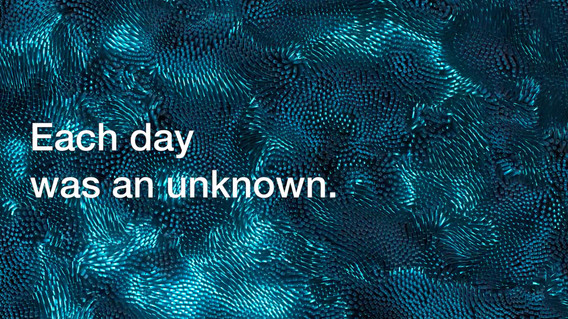
Tony Cokes. Still from The Will & The Way...Fragment 1. 2019
Media and Performance at MoMA is made possible by Hyundai Card.
Major support is provided by MoMA’s Wallis Annenberg Director’s Fund for Innovation in Contemporary Art.
Generous funding is provided by the Lonti Ebers Endowment for Performance and the Sarah Arison Endowment Fund for Performance.
Related articles
-
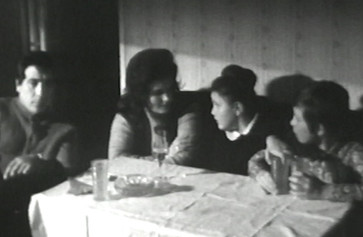
Hyundai Card Video Views
VALIE EXPORT’s Facing a Family
In this exclusive two-week screening, watch the artist use our televisions to look back at us.
Dec 21, 2021
-
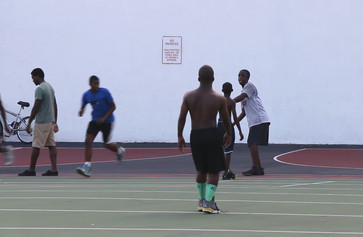
Hyundai Card Video Views
Steffani Jemison’s Personal
Watch the artist’s meditation on time and public spaces in this exclusive two-week screening.
Nov 18, 2021

